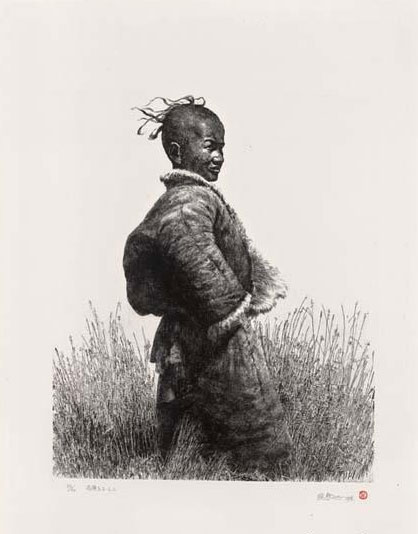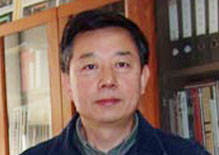“Son of the Plateau”
[File photo]
With his hair flying in the air, a young Tibetan boy stands on the tough, resilient grassland of the Qinghai-Tibet Plateau and gazes into the distance. The confident gesture of the grassland boy under a vast sky display a wild beauty infused with an unconscious bravery and vitality. This is what the Beijing-based artist Wu Changjiang has depicted in his prize-winning print, “Son of the Plateau.”
The work, along with another 24 of his prints, 13 drawings, 14 watercolors and 13 sketches, is on display at the Shenzhen Fine Art Institute through Sept. 18.
All the works on display focus on Tibetan people’s daily life scenes on the Qinghai-Tibet Plateau in West China.
Wu’s works are skillful and lifelike, reflecting his understanding of the stark simplicity of the plateau landscape and the unique lifestyle of the Tibetan people.
Born in 1954 in Tianjin, Wu has been teaching at the block print department of the Central Academy of Fine Arts in Beijing since his graduation in 1982.
An accelerated realist printmaker, Wu also acts as vice chairman of the Chinese Artists’ Association.
During his first trip to Tibet in 1983 to sketch, Wu awoke one morning to see the entire landscape covered in a dense layer of snow, broken by only a tent and a few yaks.
In Wu’s eyes, the tent was not just the Tibetan people’s living space, but also a symbol of their life force.
The dynamic black and white contrast of this scene left a deep impression on him. He decided to use the art of printmaking to capture the true spirit of real life in Tibet.
Since then, he has returned more than 30 times to the Qinghai-Tibet Plateau to sketch and gain inspirations for his artistic creations.
Wu’s works also reflect the profound impact the accelerating pace of urbanization taking place throughout China has had on Tibetan people and their culture over the past two decades.
To date, Wu has staged 23 one-man art exhibitions in Beijing, Guangzhou, Spain and Japan.
His sketches and prints have been collected by the National Museum of Fine Arts in Beijing, the British Museum in London, the Museum Ludwig in Cologne, Germany and the Portland Museum in the United States.
(Shenzhen Daily September 13, 2007)



